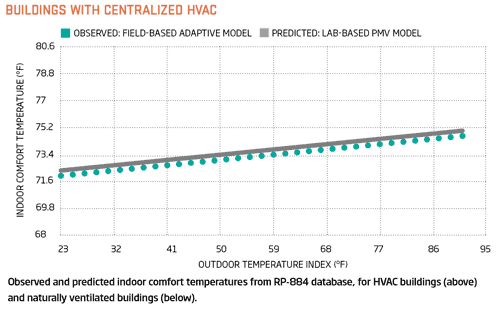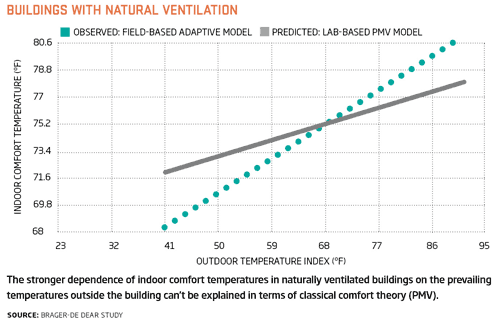The Comfort Zone
Human Adaptability
In "Thermal Comfort Temperatures and The Habits of Hobbits"-a paper from the book  Standards for Thermal Comfort: Indoor Air Temperature Standards for the 21st Century, edited by Fergus Nicol, Michael Humphreys, Oliver Sykes, and Susan Roaf (1995)-Humphreys argued that, "the adaptive, people-centered way of regarding thermal comfort suggests that it would be advantageous to reformulate temperature standards for buildings so that they reflect the empirical relation between climate and thermal comfort, and make due allowance for human adaptability."
One important study that came on the heels of this call for thermal common sense was undertaken by Gail S. Brager of the Center for Environmental Design Research, University of California, Berkeley, and Richard de Dear of the Division of Environmental and Life Sciences, Macquarie University, Sydney, Australia. With funding from ASHRAE, Brager and de Dear studied standardized thermal-related data from 160 office buildings in countries spanning four continents and representing a variety of climate zones, including Australia, Greece, Indonesia, Pakistan, Thailand, the U.S., and UK. The buildings fell into one of two categories: those with centrally controlled heating, ventilating, and air-conditioning systems (HVAC) in which occupants have little to no control over their immediate thermal environment; and those that were naturally ventilated (NV) with occupant-controlled operable windows and no mechanical air-conditioning. The database did not include enough mixed-mode buildings-those that combined mechanical and natural ventilation-to analyze this hybrid category.
In a paper titled "Climate, Comfort, & Natural Ventilation: A New Adaptive Comfort Standard for ASHRAE Standard 55," (2001), Brager and de Dear explain two dominant patterns that emerged from their data analysis: First, the comparison of observed responses in NV buildings to those of HVAC buildings "suggests that occupants of HVAC buildings become more finely adapted to the narrow, constant conditions typically provided by mechanical conditioning, while occupants of NV buildings prefer a wider range of conditions that more closely reflect outdoor climate patterns."
|
Â
Second, by comparing the observed responses to those predicted by the PMV model within each category, Brager and de Dear found that "PMV was remarkably successful at predicting comfort temperatures…in the HVAC buildings, demonstrating that behavioral adjustments of clothing and room air speeds (both of which are inputs to the PMV model) fully explained the relationship between indoor comfort temperature and outdoor climatic variation." In the NV buildings, however, the observed and predicted responses were notably different. The researchers suggest that the behavioral adjustments within the PMV model (i.e. clothing and room air speed) were not sufficient to make an accurate prediction in the case of the NV buildings and posit that a "psychological adaptation [that] is not accounted for by the PMV model" is at play. They go on to explain that, in their opinion, "indoor comfort temperatures in NV buildings are strongly influenced by shifting thermal expectations resulting from both higher levels of perceived control, and a greater diversity of thermal experiences in the building."
It appears that thermal comfort is not only a function of standard variables recognized by the conventional theory (the variables of air temperature, air velocity, mean radiant temperature, and relative humidity, and the personal variables of activity levels and clothing insulation), but is also affected by psychological variables ranging from people's expectations (due to, for example, outside conditions or cultural norms) to how much control they have over their immediate workspaces (by, for example, being able to open up a window, adjust blinds, or even move to a different location).
The Brager-de Dear study led to the incorporation of a new section into the 2004 version of Standard 55 to provide designers with a potential alternative to the traditional PMV-based comfort zone. Titled "5.3. Optional Method for Determining Acceptable Thermal Conditions in Naturally Conditioned Spaces," this optional method allows warmer indoor temperatures for naturally ventilated buildings during summer. Explains Gwelen Paliaga, senior mechanical designer at Taylor Engineering in Alameda, California, and current chair of ASHRAE Standard 55, the optional calculation method does not apply to buildings equipped with mechanical air-conditioning systems or during periods when mechanical heating systems are running.











